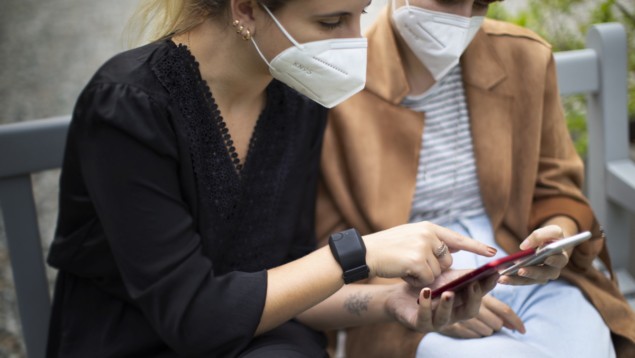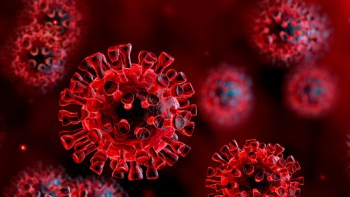
In the not too distant future, wearable biometric sensors may be able to detect the early stages of acute viral respiratory infections in people before they develop any symptoms. Such non-invasive devices could be used for infection screening to help limit community spread of airborne viruses. If a biometric sensor could also predict the severity of infection, a person could also receive faster and potentially better medical treatment.
A study conducted by researchers at Duke University showed that a wristband with biometric sensors could detect an influenza infection (H1N1) in an asymptomatic person with up to 92% accuracy, and the common cold (rhinovirus) with up to 88% accuracy. An infection severity prediction model designed by the researchers was able to distinguish between mild and moderate infection 24 hr prior to symptom onset, with an accuracy of 90% for influenza and 89% for rhinovirus, according to findings published in JAMA Network Open.
“Resting heart rate, heart rate variability, accelerometry, electrodermal skin activity and skin temperature can indicate a person’s infection status or predict if and when a person will become infected after exposure,” the researchers write. “Detecting abnormal biosignals using wearables could be the first step in identifying infections before symptom onset.”

Principal investigator Jessilyn Dunn and colleagues recruited 39 participants for the H1N1 influenza challenge and 24 for the rhinovirus challenge. The groups were inoculated with intranasal drops of diluted influenza virus or diluted human rhinovirus, respectively. The influenza group only was isolated in a clinic for a minimum of eight days after inoculation.
For the study, the team employed the Empatica E4 wristband, a medical-grade wearable device that measures heart rate, skin temperature, electrodermal activity and movement in real time. The influenza group wore an E4 wristband one day before and 11 days after inoculation, while the rhinovirus group wore the wristband four days before and five days after inoculation. The wristband recorded data continuously, which were transmitted electronically twice daily. Participants performed a nasal lavage polymerase chain reaction (PCR) test every morning to record viral shedding, and self-reported symptoms twice daily.
The researchers measured observable symptoms (including fever, stuffy or runny nose, coughing, sneezing, shortness of breath, hoarseness, diarrhoea and wheezy chest), self-reported unobservable symptoms (such as fatigue, headache, ear pain, throat discomfort, chest pain, chills, fatigue and itchy eyes) and viral shedding. Participants were divided into subgroups by infection similarity, specifically being asymptomatic or non-infected, having a mild case or having a moderate case, and by disease trajectory.
The team developed and tested 25 classification models to predict infection versus non-infection from wristband data, with each model covering a different time period after inoculation or using a different definition of infected versus uninfected. The final analysis included 31 participants for the influenza group and 18 for the rhinovirus group.
Using only data collected from the wearable device, the H1N1 models were able to distinguish between infection and non-infection with an accuracy of up to 92% for H1N1 (90% precision, 90% sensitivity and 93% specificity). Models predicting whether or not a participant was infected with rhinovirus achieved up to 88% accuracy (100% precision, 78% sensitivity and 100% specificity).
The researchers also developed 66 models for prediction of infection severity prior to symptom onset, for different time periods after inoculation. These models also performed well, distinguishing between mild and moderate infection 24 hr before symptom onset, with an accuracy of 90% for influenza and 89% for the common cold. The most important features for predicting infection severity were resting heart rate and mean heart rate variability.
The researchers report that an accuracy plateau occurred between 12 and 24 hr after inoculation, for 24 of the 25 infection detection models and for 64 of the 66 infection severity models. “This finding indicates that the most critical of the physiologic changes that occur in response to viral inoculation and that predict pending illness severity occurred within 12 to 24 hours after exposure,” they write.
Low-cost wearable devices quantify breathing activity while you sleep
Dunn says that research to improve the algorithms is ongoing, and that another influenza study will be conducted to evaluate models using different dosage levels of virus inoculation.
Dunn and Ryan Shaw, director of Duke’s Health Innovation Lab, are co-principal investigators of CovIdentify, an ongoing study launched in April 2020 to assess whether smartwatch wearers’ health, such as sleep schedules, oxygen levels, activity levels and heart rate, can be used to detect early symptoms of COVID-19. The study is currently collecting data from around 8500 smartwatch wearers, who also complete a short online survey for up to 12 months, and continues to recruit volunteer participants.
“We hope to learn what sickness with COVID-19 looks like at the physiological level, and how parameters around heart rate, sleep and movement change when a person gets infected,” Dunn explains. “We are also interested in comparing data from unvaccinated individuals, as well as people who develop breakthrough infections.”



